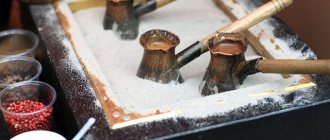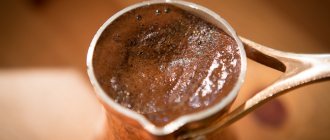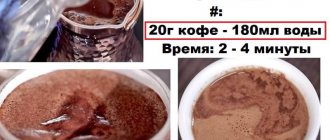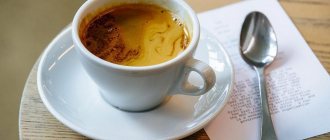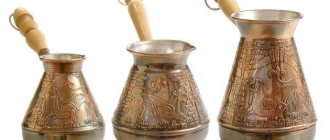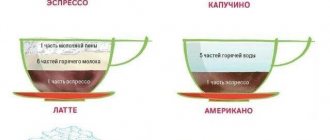Espresso is the most expensive, aromatic and tart type of coffee, which is loved by true gourmets and connoisseurs of strong drinks. It has a velvety rich taste and a long hot aftertaste. Despite the complex technology for creating this wonderful drink, it can be prepared at home. Moreover, now all the necessary tools are easy to find on the open market.
Espresso at home can be created using a Turkish coffee maker, coffee maker or automatic coffee machines. Turka provides complete control over the process of creating a drink, and the coffee maker is a mixed device with an automatic water supply mode and independent placement of coffee tablets into the cone. The quality of espresso made in a carob coffee maker depends on the coffee you choose and the ability to properly compact it in the filter reservoir.
Automatic coffee machines are the result of the latest technologies, which have reduced the process of making coffee to a minimum of time. The process from feeding the coffee base into the brewing tank to obtaining an aromatic drink takes no more than 40 seconds. These coffee machines are equipped with automatic programs that automatically add the necessary ingredients and regulate the strength of the espresso.
Not long ago, combination harvesters appeared on the market, combining the functions of a coffee grinder and coffee maker. This type of machine is convenient to use at home, as you will always have freshly ground coffee on hand, preserving its taste and aroma. However, as with a carob coffee maker, the quality of the drink will depend on your ability to properly compact the espresso coffee base in the machine's reservoir.
The right approach to choosing ingredients
The quality of the drink that subsequently ends up on your table depends on many factors. Real espresso coffee can, of course, only be made from hand-ground beans. Therefore, every detail is important:
- Type of coffee. For espresso, a mixture of different varieties of Arabica and Robusta is taken. The first is responsible for the rich aroma and attractive foam, the second is responsible for the dense structure and strength of the drink.
- Quality. Take a close look at the external condition of the purchased grains. They should have a slight shine, which is given to them by naturally occurring oils. If the grains are matte, they were probably roasted improperly.
- Storage. The first is tightness, the second condition is shelf life. You should not keep any coffee beans at home for more than 18 months, even in special packaging that prevents them from losing their properties.
- Roasting. Dark roasted beans are suitable for espresso - this is something between medium (for cappuccino) and very dark types of processing.
Selection of coffee beans
The first important step is the selection and preparation of grains. Professional baristas recommend using not one, but several varieties. Typically, the mixture is based on several varieties of Arabica, and a small amount of Robusta beans is used as a supplement. Arabica has a soft, refined taste and produces a stable, thick foam, while Robusta gives strength and richness of aroma.
When choosing grains, you need to pay attention to their appearance. A traditional espresso recipe calls for medium roast beans. Properly roasted coffee has a dark brown color and a surface shiny with essential oils.
The quality of the drink largely depends on the grind. For making espresso, a medium grind is most suitable, in which the coffee particles are the size of fine salt crystals.
The grains should be ground immediately before preparing the drink. They should be stored in an airtight, dry container for no longer than 18 months.
The fastest way to make your own espresso
At home, we have two options to create this drink - using a Turk or directly in a coffee cup. Let's start with the last one.
Oddly enough, we will need instant coffee - after all, this is the fastest way to make espresso. Just take the amount of coffee and sugar you're used to using for your morning fix and put it in a cup. Next we will need regular boiling water - add it literally a teaspoon at a time to the container with coffee, while vigorously stirring and whisking.
We are trying to achieve a characteristic light beige color, as well as a consistency reminiscent of thick sour cream. Once this has been achieved, add boiling water on top to create a portion, stir very carefully. Dense white foam will be a signal that everything was done as it should. But, of course, to make truly excellent coffee at home, you need skill and time.
Espresso in a coffee maker - a real barista's recipe
True coffee connoisseurs purchase modern coffee machines that reduce the process of preparing the drink to a minimum: you just need to press one button. However, real espresso requires special steam technology, so using an automated system will not achieve a bright taste.
To create various coffee drinks at home, it is better to purchase a carob coffee maker, which allows you to independently regulate the process of preparing the drink.
The recipe for real espresso is easy to follow; all you need to do is follow the sequence of steps and remember a few subtleties:
- The first step is to place the ground coffee into the filter tank. The espresso base should be moderately dense so that water can seep through the coffee tablet evenly. Therefore, the mixture should be compacted with vigorous pressing movements, as if compressing it.
- Before pressing the pour button, you can do an interesting trick: lightly hit the ear (protruding part) of the holder to shake the coffee off its walls. It is also advisable to clear the coffee paths of any remaining grounds from the previous shot of espresso.
- Now we insert the holder into the coffee machine reservoir and immediately turn on the water dispensing button. This is necessary so that the coffee tablet does not have time to undergo a temperature change, otherwise the drink will become bitter.
- The appearance of golden nutty foam indicates that you have successfully prepared espresso. By the way, it is by the quality of the foam that you can determine whether the technology for its creation was followed correctly. The recipe from the barista assumes the presence of smooth and dense foam, the thickness of which should be at least 2 mm.
- To ensure that the foam turns out exactly like this, use a little trick: before preparing the drink, place the cups on the surface of the coffee machine so that their inner walls warm up. In this case, there will be no temperature difference after the water is supplied.
Important! After preparing espresso, immediately remove the compressed coffee tablet from the holder. Otherwise, oils will accumulate in the coffee machine, and each subsequent drink will begin to taste rancid.
Classic espresso coffee in Turk
To prepare a 30 ml portion, we will need:
- ground coffee – 2 teaspoons
- sugar – 2 teaspoons
- coarse salt – 2–3 grams
- water
Take a Turk, put the specified amount of coffee in it, then sugar and salt. After mixing these substances, place the container on low heat. The point is to warm up the coffee, so it will give off the necessary aroma and taste. As soon as you feel that a characteristic pleasant smell has begun, add a glass of water. It should be warm to speed up the process. Bring the resulting mixture to a boil.
As soon as bubbles appear, immediately remove the coffee from the heat, pour it into a cup, and then leave it under the saucer for ten minutes. The espresso is ready, you can add toppings as desired.
To make the coffee tasty and aromatic, when heating the dry mixture, keep the Turk a couple of centimeters from the fire, stirring the ingredients regularly.
Portable coffee makers for making espresso coffee at home
A cup of aromatic coffee in the morning is the dream of almost every inhabitant of the planet. But what to do if you are on the road or there is no coffee machine nearby? Portable coffee makers were created especially for such cases. Today we have a huge number of product choices. Each of them differs in functionality.
Most often, such a device looks like an ordinary thermal mug, but in fact it is just the dream of any coffee lover! You need to pour the beans into the mill, then brew them with boiling water through a filter, then remove the used film and you have fresh and aromatic coffee in your hands.
Types of espresso and their preparation
Perhaps not everyone will like only the classic version of this invigorating and bright drink. At home, you can prepare several versions of it, depending on the amount of ingredients:
- Actually a classic version. For 30 ml of water, take one teaspoon of finely ground coffee. Prepared according to the previously presented recipe in Turk.
- Doppio. From Italian this word is translated as “double”, that is, all the ingredients of the classic version are doubled, everything is prepared without changing the technology.
- Ristretto. A more “strict” option, when half as much water is taken to make the drink even more rich. Suitable for true connoisseurs of espresso coffee.
- Macchiato. To prepare this variety at home, simply add a little milk on top of the finished drink, brought to a foamy state.
- Lungo. Add the finished coffee with hot water to obtain a volume of 50 ml.
- Konpanna. Pour a standard amount of espresso into a cup. You can optionally add whipped cream, grated chocolate, and lemon zest on top.
- Romano. This citrus option is designed to refresh the coffee and diversify it. A small slice of lemon or orange is simply served with espresso brewed according to the classic recipe.
- Coretto. As an addition, for example, whiskey or liqueur can be used. Moreover, there are special names for such drinks depending on the type of alcohol chosen. Espresso with whiskey is Irish coffee, with vodka is Russian coffee, with schnapps is German coffee, with gin is English coffee. If we take the Italian version, then it is traditionally amaretto.
- Glasse. To prepare it, espresso is brought to a temperature of 10°, and then ice cream, cinnamon, chocolate or caramel are added as desired in proportions of 1:3.
- Cappuccino. A special feature of this type is the abundant milk foam. In Italy, it is customary to drink cappuccino for breakfast. You can add grated chocolate on top.
- Americano. In fact, this is a standard shot of espresso, diluted to the full volume of a coffee kettle. They are usually served in standard cups (120 ml).
- Latte. Here, rather, coffee acts as an addition; the basis is heated milk, into which espresso is poured in a small stream. On top is milk foam.
- Mocha. This is the same latte, only in changed proportions. Espresso and toppings are taken in a ratio of 1:3.
Espresso quality check
Real espresso has a stable foam, at least two millimeters thick. If you pour sugar on it, the crystals do not immediately sink, but slowly sink through this layer. Depending on the type of grain used, the foam has a chocolate, light brown or beige tint.
Coffee brewed on the stove should have an extraordinary taste. This drink is characterized by the presence of bitterness, sweetness, slight sourness and saltiness.
The presence of a taste of overcooked grains or other notes is unacceptable. Also, the presence of unpleasant shades in the aroma is unacceptable.
Coffee Frappe
Brew a shot of espresso in its classic variation and let it cool. To prepare, you will need a glass that can be hermetically sealed, such as a shaker. We pour the prepared coffee there, add a couple of teaspoons of sugar and no more than 5 tablespoons of water.
Close the glass and shake it thoroughly - you should get plenty of foam. Now take a serving glass, a transparent one will look very advantageous. Place a few ice cubes there and pour the resulting coffee foam on top.
If you find the drink too strong, you can add cream or cold milk to taste. All that remains is to mix everything.
How to serve espresso
To enjoy a flavorful drink, you need not only to prepare the coffee correctly. Espresso requires a certain delivery. Following several rules will preserve its temperature and taste:
- To serve, use small porcelain cups with thick walls - demitas. Their volume is designed for one serving of drink.
- Before pouring the coffee, warm the cups slightly. You can warm them up either in a coffee machine or by pouring boiling water inside.
- Another important condition: the drink should occupy no more than 2/3 of the volume of the cup, otherwise it will cool down and lose its taste.
Espresso in French press
To avoid damaging the glass, first rinse the glass with hot water. Place four tablespoons of ground coffee in the bottom of the container. As soon as the water in the kettle begins to boil, turn it off and pour in coffee for two servings (500 ml). Do this slowly and carefully.
Then begin vigorously stirring the resulting mixture, and then slightly lower the press filter down. Let the drink steep for about five minutes - the longer, the stronger the coffee. Now slowly lower the filter all the way and pour the espresso into the cups. Be sure to use a strainer.
How to make espresso at home
If you don't have a coffee machine, the process will remain essentially the same. We need to pass 40-50 ml of water through 7-10 grams of coffee. We can, of course, conclude that as a result we will get the “Wrong Drink”. The taste will vary. But who said they would be worse? You might like it.
You can try brewing homemade espresso in a Turk, or simply brew it.
If you want to use the first option, proceed as follows.
- Place the Turk on the stove and let it warm up.
- Add ground coffee and clean water.
- Prepare your drink. But keep in mind that the coffee should not boil.
- Let the foam appear. Now remove from heat. We repeat this three times.
- Pour the finished drink into a cup.
As for ordinary brewing, pour the coffee into a suitable container (see DIY paper filters for coffee makers), and fill it with hot water. Now you need to wait a couple of minutes, and you can drink.
Espresso-based drinks
There are about 15 famous coffee drinks that each coffee shop offers. Among them:
- Americano is a less concentrated analogue of espresso due to the larger amount of water;
- latte – milk coffee;
- cappuccino - with whipped milk and foam;
- mocha is an analogue of latte with different proportions of components;
- frosted glass with the addition of ice cream;
- doppio - brewed like classic espresso, but the number of components is doubled;
- ristretto - a less strong drink, but richer in taste;
- Romano - with the addition of a citrus slice;
- coretto – with alcoholic additives;
- raf - mix all the ingredients and beat until foam forms.
The basis in all cases is espresso brewed in a coffee machine or other methods.
Secrets of making espresso
So, let's understand all these "M". To prepare classic espresso, coffee is best used in a very finely ground mixture of Arabica and Rabusta. If you are buying melange for a car, then it is better to choose the brands “La Semuz Don Marco”, “Molinari Classico”, “Lavazza Crema Aroma”, Danesi Classic and Arcaffe Gorgona. Why does the grind have to be fine? After all, coffee is not brewed for espresso. In order for the powder to impart its properties, taste and aroma to water, it must be crushed into dust.
The next "M" is a car. It's good if it's a full automatic. Then the coffee maker passes water through a tablet or holder, heated exactly to 90 degrees (no more and no less) under a pressure of nine bar. What is also important is the time elapsed from fixing the portafilter to pressing the corresponding button on the machine. It should not exceed two seconds.
Now about the human factor. It is important to compact the freshly ground powder mixture into the holder. You need to add 8 grams for one serving of classic espresso. Flatten and compact it to form a “tablet”. Baristas know that the pre-infusion period should be one and a half seconds, and a 30 ml drink should be extracted in half a minute.
Varieties of espresso
Coffee using the classic steaming method is served in portions of 25-35 ml. Do you want more? Prepare an “espresso doppio”, simply a double portion of the drink. Are you taking care of your liver? Then brew an “espresso lungo”. In this case, only the amount of water increases (60-75 ml). In “espresso-ristretto” it’s the other way around. Pour just a little water: 18-20 ml. In macchiato, we soften the taste of regular espresso coffee with a tablespoon of warm steamed milk. This makes the drink appear “speckled.” In "espresso con panna" (another name for "tazza d'oro" - golden cup) we cover the coffee with a cap of whipped cream. In Romanno (Roman style) add a couple of drops of lemon juice or rub a little zest into a cup. And finally, the evening “corretto” (seasoned). In Italy, grape vodka grappa is added to this drink; outside the Apennine Peninsula, a small amount of liqueur is added.
Making espresso coffee using a coffee maker.
If you are the happy owner of an espresso coffee maker, then your coffee will taste better than that of those who brew it in a Turkish coffee maker. There are 3 types of espresso machines: manual water dispenser, automatic water dispenser and automatic coffee maker.
We prepare espresso in a coffee machine with manual dosing. 1) Place 7-9g of ground coffee in a holder and compact with tamper. (You can find out more about the holder and tamper in the article, which describes how to properly prepare espresso coffee.) 2) Press the water start button. 20-30 seconds is the global standard for filling a cup of coffee with 30 ml of water. 3) Enjoy the delicious taste of espresso coffee prepared in an espresso machine with manual dosing of water.
We prepare espresso in a coffee machine with automatic dosing in the same way as in the previous method. The only difference is that water is supplied automatically, without your intervention.
In a 100% automatic coffee machine, preparing coffee is even easier: 1) Pour the beans into the coffee grinder. 2) Pour water into a special compartment. 3) Click the “Start” button. 4) Enjoy espresso coffee prepared at home.
Some time later we will present to your attention an article where we will describe the step-by-step process of making espresso in Turk. Feel free to bookmark the website.
As a result, I will give a couple of links to articles on our website on the topic of “espresso”: what is the difference between Americano and espresso, how to brew espresso. Love coffee.
Espresso coffee.
Espresso is a method of making an infusion from highly roasted coffee beans, producing traditional dark coffee, thickly rich and fragrant.
The most difficult and expensive method of making coffee is espresso. The word “espresso” comes from the French word express, “specially”, “purposefully”, in other words it means that such coffee is always prepared individually, for 1 person.
Others believe that the name comes from the Italian expression “to keep under pressure, under pressure,” thereby reflecting the technological features of making the drink.
The essence of the espresso coffee making process is that boiling water and steam are forced through a portion of very finely ground coffee. The working pressure of professional espresso machines is 9 atmospheres.
At the moment, more coffee fans are acquiring automatic and semi-automatic espresso machines, with the help of which the process of making this drink is reduced to the usual pressing of a button. Coffee machines can be called the horse that carries us to success in making espresso.
If you decide to get an espresso machine, forget about being frugal. Cheap machines are not equipped with a pressure blower, and they will not produce good espresso. Many manufacturing companies produce complex products with built-in coffee grinders.
These coffee processors are much more expensive. But imagine how much money you can save if you drink espresso brewed at home, rather than overpay for each cup that is offered to you in a cafe. By the way, it’s not a fact that a cafe will serve you good espresso.
The main differences between Americano coffee and espresso
The main differences between Americano and espresso:
- The volume of espresso is only 25 - 30 ml, and Americano - more than 150 ml.
- Espresso is preferred by gourmets and connoisseurs of the bitter taste properties of natural coffee. Americano will appeal to those who do not like bitterness.
- Espresso is prepared only by steam distillation, and Americano is prepared by continuous pouring.
- To make Americano, the beans are ground coarser than for espresso.
- Foam is an essential feature of properly prepared espresso, but it may not be present in an Americano.
Espresso is a drink for connoisseurs who appreciate the unmatched aroma and nutty flavor of real, high-quality coffee.
Fundamental tips for those who want to figure out how to make espresso coffee at home. We recommend you check it out!
- Introduction
- Choosing a variety
- Choosing a roast
- Properties of black roasted beans
- What ingredients are needed
- Step by step recipe
- We prepare Americano and other drinks
- Milk rivers: macchiato, glasse, latte and cappuccino
- How to make in a coffee machine
This invigorating drink is very popular in all corners of the Earth. If you also love espresso and want to master the art of making it, then read the materials in this article. Especially for you, we have collected the most pressing tips - and prepared a step-by-step summary for creating the most delicious drink at home.
Before we talk about how to brew espresso coffee, we will explain the main nuances of choosing a variety. Professional baristas often use not a single variety, but a mixture formed from different types of Arabica. This allows you to achieve a multifaceted, but at the same time balanced, bouquet and the desired level of strength.
Robusta coffee beans can also be included in the mixture - however, in a very small percentage of Arabica. The fact is that Arabica has a more gentle, unique and generous taste. She is specifically responsible for the flavor pyramid of coffee. Whereas Robusta is coarser, bitter and full-bodied. At the same time, it forms the strength of the drink - and makes it a real energy drink, helping to wake up and gather ideas early in the day. The coffee chosen for espresso – it doesn’t matter whether it’s a single variety or a blend – should be full-bodied and sweet. This will balance out the bitterness inherent in this recipe. In addition, coffee beans should not have pronounced acidity. If the pyramid is dominated by sour fruit and berry notes, then this variety cannot be used to make espresso.
Brazil Mogiana
- 5
Brazil Santos
- 4.9
Costa Rica Tarraza
- 4.8
Another important aspect is the degree of roasting. For espresso, you must use actively roasted beans. The higher the roast level, the more intense and bitter the taste of the drink will be. A weak (light) degree of heat treatment helps to reveal sour notes, and a powerful (black) degree gives the coffee a generous bitterness and astringency. Depending on the variety, black roasting produces notes of dark chocolate, hazelnuts or tobacco.
Rules for preparation and serving
Classic recipe
Now about how to make espresso in a Turk. The proportions for the recipe are as follows - 2 tsp. ground coffee, 40 ml water, a pinch of salt, sugar to taste.
Add ground grains, sugar and table salt to a copper pot. Mix the composition.
The mixture is heated before cooking. Set the temperature to the minimum and keep the Turk at a distance of 2-3 cm from the burner or fire on the gas stove.
Stir the mixture constantly to prevent it from burning.
After 1.5-2 minutes, brew the mixture with water and put on fire. Remove the Turk from the stove when bubbles appear on the surface of the water and the foam begins to rise. Stir well, put back on the fire and wait for the second boil.
Interesting! Pressure in a coffee maker: how much bar should it be
Brew the espresso, remove the Turk from the heat and immediately pour the drink into the cup. Within 2-3 minutes the foam will subside.
An electric stove heats up slowly and takes a long time to cool down. Do not leave the Turk on the switched off burner even for a minute. The drink will boil again and “escape.”
Supplements
According to the Italian recipe, toppings are not added to espresso. But today, baristas serve the drink based on the guest’s wishes. Milk is poured into the espresso, the foam is sprinkled with cinnamon and grated nuts.
But additives worsen the original taste of black coffee and make it softer.
Let's check the quality
Properly prepared coffee from quality beans has a multi-faceted, deep taste. The aroma is rich without any unpleasant odors.
At the same time there is bitterness, sourness and a sweetish aftertaste. After the first sip, you should not feel any burnt grains.
How to Serve Coffee
The drink is poured into special porcelain coffee cups - demitas (demitasse). Their feature is a thickened bottom and walls, which prevent the espresso from cooling quickly.
Standard volume is 40-60 ml. They also produce 90 ml cups for the drink according to a modern recipe with additives.
Pour espresso into a warmed cup. Heat will better reveal the aroma and preserve the velvety foam longer.
To heat the dishes, pour boiling water or rinse with hot tap water.
The temperature of the coffee when serving should be 67-70°C.
